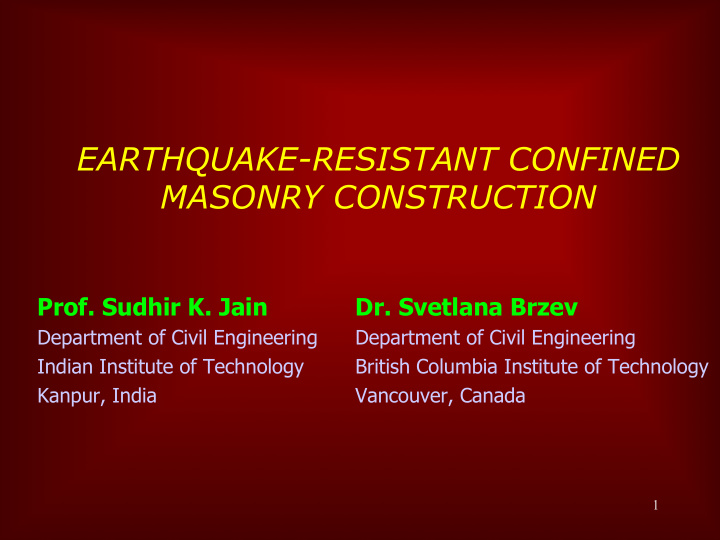



EARTHQUAKE-RESISTANT CONFINED MASONRY CONSTRUCTION Prof. Sudhir K. Jain Dr. Svetlana Brzev Department of Civil Engineering Department of Civil Engineering Indian Institute of Technology British Columbia Institute of Technology Kanpur, India Vancouver, Canada 1
EARTHQUAKES HAPPEN …and they can be very destructive 2
Recent Deadly Earthquakes in the World Ø 1993 Latur, Maharashtra, India – 8000 deaths Ø 1999 Ducze, Turkey – 20000 deaths Ø 2001 Bhuj, Gujarat, India – 14000 deaths Ø 2003 Boumerdes, Algeria – 3000 deaths Ø 2004 The Great Sumatra Earthquake and Tsunami in Indonesia, Thailand, Sri Lanka, and India - 270,000 deaths Ø 2005 Kashmir Earthquake in Pakistan and India -100000 deaths 3
Building Construction Affected by Earthquakes Ø Both low-rise and high-rise construction Ø Both rural and urban construction Ø Both masonry and concrete construction 4
CONFINED MASONRY: an opportunity for improved seismic performance both for unreinforced masonry and reinforced concrete frame construction in low- and medium-rise buildings 5
Confined Masonry Construction: An Alternative to Reinforced Concrete Frame Construction An example from Chile (Source: Ofelia Moroni) 6
Confined Masonry Construction: An Alternative to Unreinforced Masonry Construction An example from Indonesia (Source: C. Meisl, EERI) 7
Confined Masonry Construction: a Definition Confined masonry is a construction system where the walls are built first, and RC columns and beams are cast afterwards. 8
A difference between the confined masonry and reinforced concrete frames = construction sequence Confined Masonry Reinforced Concrete Frame – Walls first – Concrete first – Concrete later – Walls later 9 Source: Tom Schacher
Reinforced Concrete Frame Construction 10
Confined Masonry Construction 11
Key Components of a Confined Masonry Building Key structural components of a confined masonry building are: Ø Masonry walls made either of clay brick or concrete block units Ø Tie-columns = vertical RC confining elements which resemble columns in reinforced concrete frame construction. Ø Tie-beams = horizontal RC confining elements which resemble beams in reinforced concrete frame construction. 12
Components of a Confined Masonry Building 13
Key Elements – Layout Rules 14
Typical Floor Plans – Examples from Chile Source: O. Moroni and M. Astroza 15
Typical Floor Plans – Examples from Chile Source: O. Moroni and M. Astroza 16
Confined Masonry – Opportunity for Phased Construction Source: M. Blondet 17
Confined Masonry: Construction Process Source: Tom Schacher 18
Confined Masonry: Construction Process Indonesia (C.Meisl) Slovenia (Lutman and Tomazevic) 19
Confined Masonry Under Construction – Worldwide Ø Mexico Ø El Salvador Ø Indonesia Ø Pakistan 20
Confined Masonry: Construction Details Good connections are of critical importance! 21
Poor Connections=>Poor Earthquake Performance 22
The Importance of Quality Construction Key points: ü Qualified construction labour ü Good quality building materials (bricks, cement, sand, steel, etc.) ü Good detailing according to recognized construction guidelines ü Regular site inspection by qualified inspectors Source: M. Blondet 23
Earthquake Performance Confined masonry construction has been practiced in countries/regions with very high seismic risk, such as Ø Latin America (Mexico, Chile, Peru, Argentina), Ø Mediterranean Europe (Italy, Slovenia), Ø South Asia (Indonesia), Ø Middle East (Iran) and Ø the Far East (China). 24
Earthquake Performance Confined masonry construction has been exposed to several destructive earthquakes: Ø 1985 Lloleo, Chile (magnitude 7.8) Ø 1985 Mexico City, Mexico (magnitude 8.0) Ø 2001 El Salvador (magnitude 7.7) Ø 2003 Tecoman, Mexico (magnitude 7.6) Ø 2007 Pisco, Peru (magnitude 8.0) Ø 2003 Bam, Iran (magnitude 6.6) Ø 2004 The Great Sumatra Earthquake and Tsunami, Indonesia (magnitude 9.0) Ø 2007 Pisco, Peru (magnitude 8.0) Confined masonry buildings performed very well in these major earthquakes – some buildings were damaged, but no human losses 25
Confined Masonry Performs Very Well in Earthquakes A six-storey confined masonry building remained undamaged in the August 2007 Pisco, Peru earthquake (Magnitude 8.0) while many other masonry buildings experienced severe damage or collapse 26
Confined Masonry Performs Very Well in Earthquakes Confined masonry buildings in town of Santa Cruz Analquito still standing, while the surrounding adobe construction was destroyed in the 2001 El Salvador earthquakes (magnitudes 7.7 and 6.6) which killed 1100 people 27
Importance of Construction Quality 28
Earthquake Resistance of Confined Masonry Building Has Been Tested using Earthquake Simulation Facilities Shake-Table Testing of a 3-storey Confined Masonry Building at UNAM, Mexico (Credit: Sergio Alcocer and Juan Arias) 29
Conclusions Ø Confined masonry construction can be practiced as a viable alternative to reinforced concrete frame construction for low-rise and medium-rise buildings Ø Minor changes in construction practice can lead to significant improvement in earthquake performance Ø Many lives can be saved and people can continue to inhabit their homes after an earthquake 30
Further Reading New NICEE Publication December 2007 To obtain a copy, contact nicee@iitk.ac.in Or order online at www.nicee.org 31
Acknowledgements Ø National Information Center of Earthquake Engineering (NICEE), Kanpur, India (www.nicee.org) Ø Natalia Leposavic, B.Arch, BCIT, Vancouver, Canada Ø Dr. Marcial Blondet, Catholic University of Peru, Lima Ø Tom Schacher, Architect, Swiss Society for Earthquake Engineering, Piandeso, Agarone, Switzerland Ø Dr. Elizabeth Hausler, Build Change, San Francisco, California Ø Several colleagues-contributors to the World Housing Encyclopedia Project (www.world-housing.net) 32
Recommend
More recommend